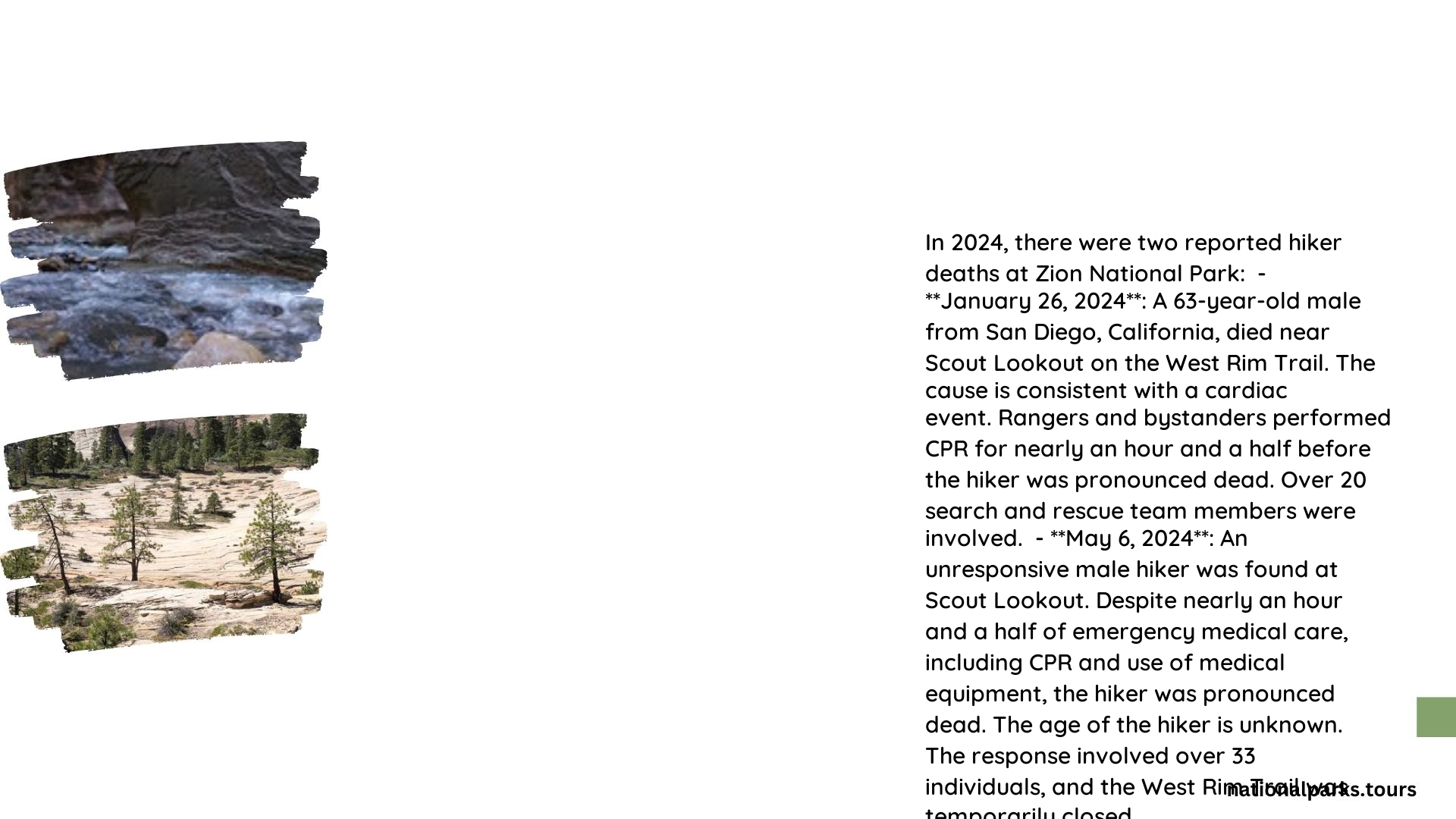Zion National Park, renowned for its stunning landscapes and challenging trails, has unfortunately witnessed numerous hiker fatalities over the years. Since 1908, at least 43 deaths have been documented, with 22 due to falls and 3 from drownings. The infamous Angels Landing trail alone accounts for 18 confirmed deaths as of 2024, primarily from falls off steep cliffs. This article delves into the statistics, causes, and safety measures surrounding hiker deaths in Zion National Park.
What Are the Key Statistics on Hiker Fatalities in Zion National Park?

Overall Fatality Numbers
- Total documented deaths since 1908: At least 43
- Deaths due to falls: 22
- Deaths from drowning: 3
- Other causes: Medical emergencies, suicides
Angels Landing Specific Data
- Confirmed deaths on Angels Landing: 18
- Deaths from falls on Angels Landing: 16
- Health-related deaths on Angels Landing: 2
Annual Fatality Trends
- Average deaths from falls on Angels Landing since 2017: Nearly 1 per year
What Are the Primary Causes of Hiker Deaths in Zion?

- Falls from steep cliffs (especially on Angels Landing)
- Health-related issues (e.g., heart attacks)
- Drownings in the Virgin River
- Flash floods (particularly in narrow canyons)
- Exposure to extreme weather conditions
How Can Hikers Stay Safe in Zion National Park?
To minimize the risk of accidents and fatalities, hikers should follow these crucial safety tips:
- Assess personal abilities and choose appropriate trails
- Stay on designated paths and avoid shortcuts
- Remain vigilant of surroundings and weather changes
- Use proper hiking gear, including sturdy shoes and adequate water
- Hike in groups and maintain communication
- Use chain handrails where provided (e.g., on Angels Landing)
- Check park alerts for flash flood warnings before entering narrow canyons
- Carry a first aid kit and know basic emergency procedures
What Specific Incidents Have Occurred in The Narrows?
While specific recent incidents in The Narrows are not detailed in the provided sources, this area is known for its susceptibility to flash floods. General incidents in Zion National Park include:
- Falls from high points (e.g., a 250-foot fall at Scouts Lookout in 1987)
- Drownings during flash floods
- Medical emergencies in remote locations
How Effective Are Rescue Efforts in Zion National Park?
The park’s search and rescue team coordinates rescue efforts with the following characteristics:
- Response times vary based on incident location and accessibility
- Resources include park rangers, medical personnel, and helicopter assistance when necessary
- Success rates are generally high, but challenging terrain can complicate rescue operations
Rescue Operation Example
In the case of park ranger John Ethridge’s fall in Hidden Canyon, park personnel reached the body approximately one hour after the incident occurred.
What Is the Trend in Hiker Fatalities Over the Past Decade?
The past decade has shown consistent patterns in hiker fatalities:
- Increased deaths on Angels Landing, averaging nearly one per year since 2017
- Notable recent fatalities include:
- Jason Hartwell (2021)
- Savannah McTague (2019)
- Tammy Grunig (2019)
- Overall park fatalities remain relatively stable, with falls as the leading cause
How Does Zion National Park Compare to Other Parks in Terms of Danger?
According to a recent ranking, Zion National Park is considered the 10th most dangerous U.S. national park. This ranking takes into account factors such as:
- Number of annual visitors
- Frequency of search and rescue operations
- Fatality rates
- Types of hazards present (e.g., steep cliffs, flash flood-prone areas)
What Measures Has the Park Implemented to Improve Safety?
To address the issue of hiker deaths, Zion National Park has implemented several safety measures:
- Installation of chain handrails on dangerous sections of trails
- Improved signage warning of hazards and difficulty levels
- Permit system for popular trails to manage crowd sizes
- Regular safety briefings and educational programs for visitors
- Enhanced weather monitoring and alert systems for flash floods
- Increased presence of park rangers on popular trails
How Can Visitors Prepare for a Safe Trip to Zion National Park?
Proper preparation is key to a safe visit to Zion National Park:
- Research trails and choose those matching your skill level
- Check weather forecasts and park alerts before your visit
- Pack appropriate gear, including:
- Sturdy hiking boots
- Plenty of water and snacks
- Sun protection (hat, sunscreen, sunglasses)
- First aid kit
- Map and compass or GPS device
- Inform someone of your hiking plans and expected return time
- Attend ranger-led programs to learn about park safety
- Consider hiring a guide for challenging hikes if you’re inexperienced
By understanding the risks and taking proper precautions, visitors can greatly reduce the chances of becoming another statistic in Zion National Park’s hiker death records. Remember, safety should always be the top priority when exploring this beautiful but potentially dangerous natural wonder.
References:
1. https://theworldtravelguy.com/angels-landing-deaths-list/
2. https://kutv.com/news/local/zion-national-park-is-no-10-in-ranking-of-most-dangerous-us-parks
3. http://npshistory.com/morningreport/incidents/zion.htm
